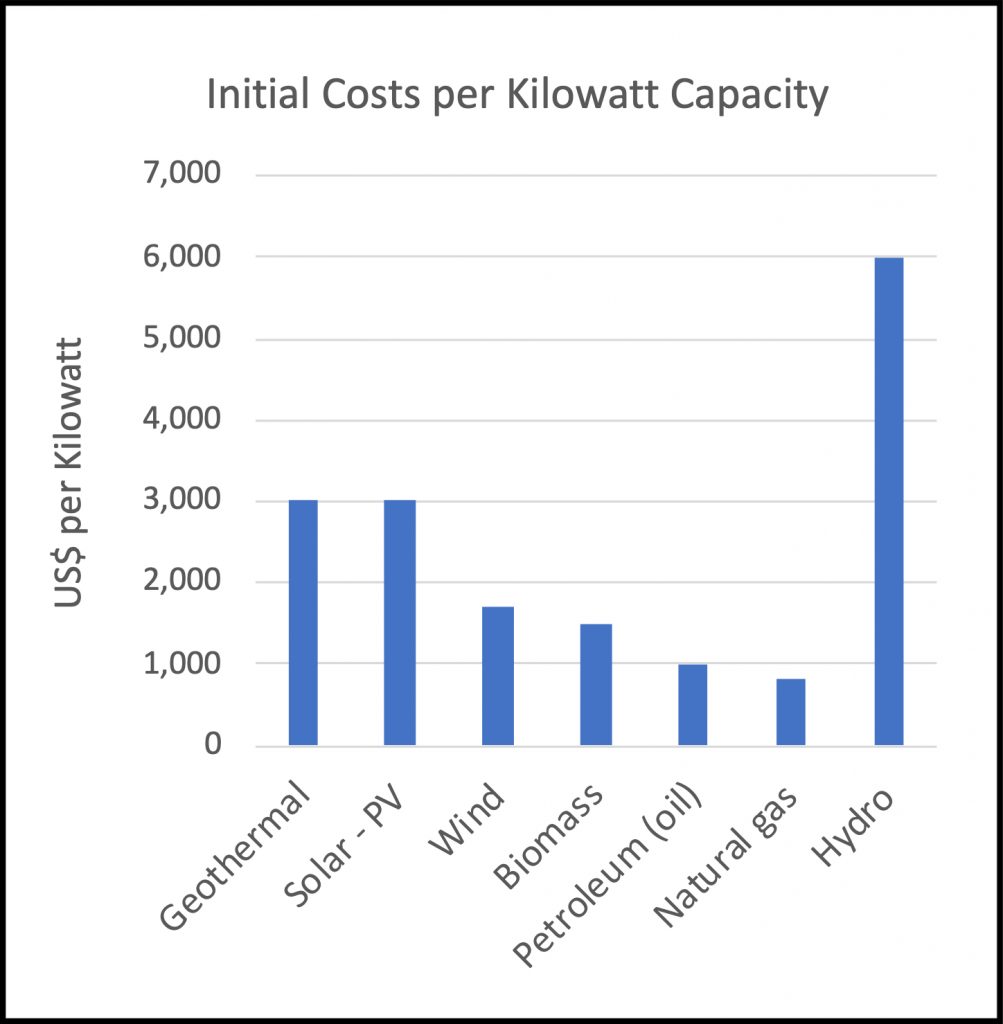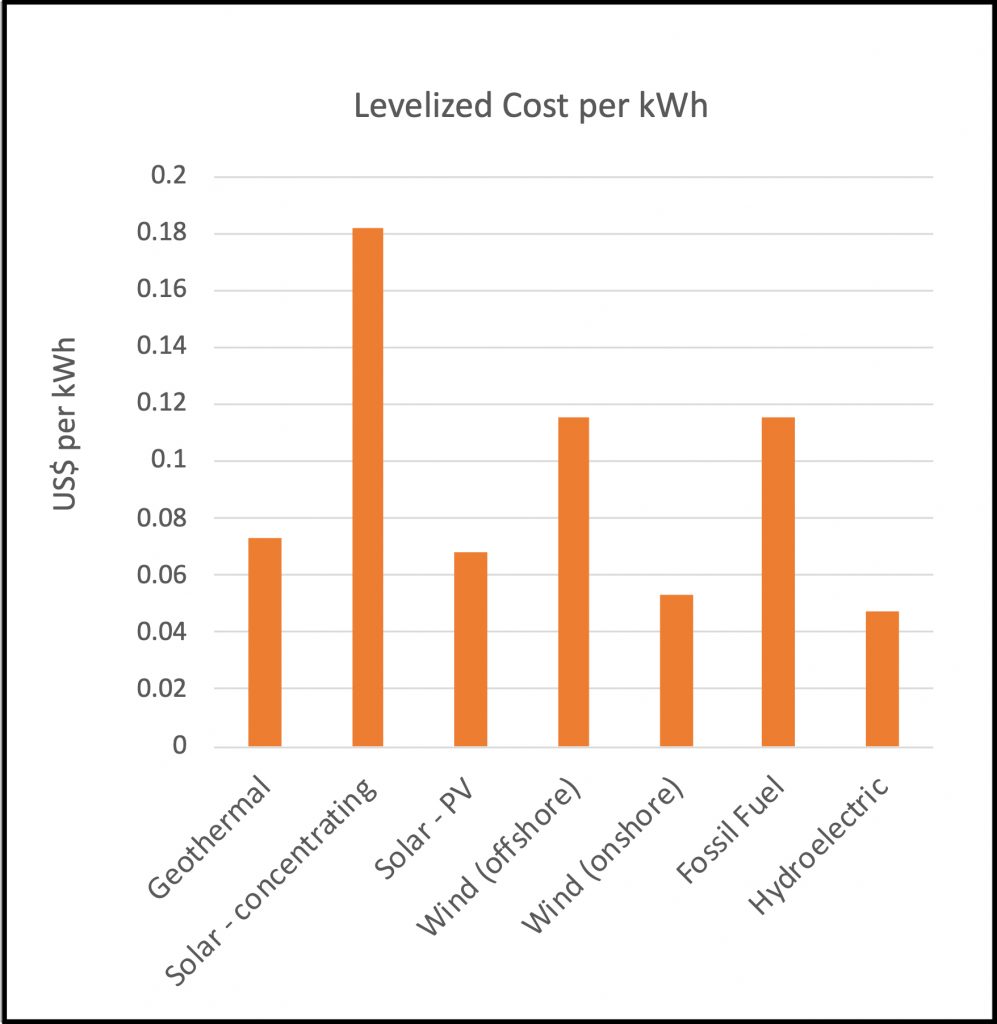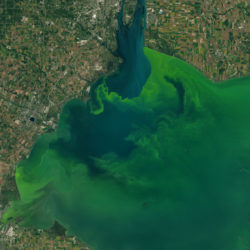UPDATED
How can we produce enough energy to live well without creating a level of greenhouse gases that generates an increasingly hostile climate? Alternative energy sources like wind and solar are part of the answer, but it isn’t going to be easy to replace the massive quantities of energy currently derived from non-renewable sources such as coal, natural gas, and oil. A useful hub for information on ‘green energy’ sources, defined as those that do not increase the world’s output of carbon to the atmosphere, can be found here.
It’s hot down there
As it happens, we live over a screaming-hot furnace which can be used to generate electricity and heat with almost no greenhouse gases and no radioactive waste. That furnace is the mantle of the earth, and its energy is available at a very reasonable cost. For example, the deepest gold mine in the world, Mponeng, near Johannesburg, South Africa, is 4 kilometers below the surface. To enable humans to work in it, the mine is cooled with an ice slurry. Uncooled, the temperature would be about 66ºC (150ºF). Although that sounds hot, it’s much cooler than the temperature at the same depth below some parts of the world. At a site known as Meager Mountain in southwestern British Columbia, for example, the temperature two kilometers down is 250ºC (480ºF). Hot enough to bake sourdough bread.
The heat of the earth derives from several sources. Some of it was generated during the earth’s formation and has not yet dissipated from the core. About half of the heat comes from the decay of radioactive elements, which is continuous. Inner earth won’t be cooling much over the next several billion years.
The temperature of the earth’s iron core can’t be measured directly, but indirect methods suggest it is between 4,000 and 7,000ºC, about the same as the surface of the sun. The mantle carries heat to the surface by convection, and the earth radiates heat from the surface equal to three times the world’s total energy consumption. This energy dissipation is diffuse, and difficult to trap. In most places on the surface, the crust is too thick to allow access to the mantle’s heat, but at some places, particularly at the boundaries of tectonic plates, it can be quite thin. As a result, such regions may be seismically active, and they may have volcanic activity. Meager Mountain is one of these places, and it’s available for energy generation.
Using geothermal heat
Air-sourced heat pumps, which transfer heat from the outside to the inside of buildings during cool weather, can deliver about twice as much heat as the electrical energy they consume. But an even greater efficiency is obtained with heat pumps that uses the earth as the source of heat. Below 6 meters, the earth retains an almost constant temperature year-round, around 10ºC (50ºF) in most places that need heating. Ground-sourced heat pumps circulate a liquid to this depth, and then through the heat pump, which extracts the heat absorbed from the earth. Such a system can decrease electrical consumption, compared to baseboard heating, by 3 to 4 – fold.
A second kind of heat extraction from the earth is provided where the earth is much warmer near the surface. Such sources provide hot water (below about 150ºC) for inexpensive direct heating. For example, Iceland heats almost all of its building by pumping water out of hot rocks that are found near volcanoes.
The most generally useful geothermal energy is obtained where the mantle is close to the surface. There, superheated water or steam can be extracted with temperatures above 150ºC. This steam, or superheated water, can drive turbines to generate electricity. This is what is proposed for the development at Meager Mountain, which is on the edge of the Pacific tectonic plate.
Currently, electricity is generated at geothermal stations in 26 countries in the world, and the number of new plants is increasing rapidly. Most stations have several wells. The United States has the greatest number of stations, more than 30, mainly in the western part of the country, near the boundary of the Pacific plate.
Most older geothermal power generators drive electrical turbines with the superheated water or steam obtained from deep wells. But today, “binary systems” are preferred. In these, the hot liquid or steam from below ground is put through a heat exchanger, through which a second liquid is circulated in a closed system. The liquid in the closed system then drives turbines.
A third system is currently being developed by a company in Alberta, Eavor Technologies. Water is circulated through the hot zone with a closed loop system laid at a depth of 2-3 kilometers. No external energy is needed to circulate the hot liquid: it returns to the surface by convection. The lighter, hot liquid rises to the surface, and after cooling in the generating system, it sinks.
The company has built a test structure that brings heat to the surface by convection, and it has signed an agreement with a German company to build a 100-megawatt commercial plant in Bavaria. The company’s chief executive hosted the German chancellor at the site in August 2023. It is expected to start producing power, in the form of heating for houses, and electricity, in 2024, and to be fully productive in 2026.
How much does geothermal power cost?
Geothermal power plants have a feature that makes them unattractive to politicians and investors: the initial cost is large. They share this feature with hydroelectric power plants. In 2015, the costs of constructing various types of power plants, in US dollars per kilowatt (one thousand watts) of capacity, was approximately as shown in this graph:

A kilowatt is approximately the electrical energy requirement of a typical home in North America. In other words, about $3,000 has to be sunk into the construction of a geothermal plant to provide energy for one home. Amortized over a 30-year plant lifetime, which is a conservative estimate, this amounts to $100 per year per household. Plants powered by natural gas cost about 75% less to build, but they need fuel.
A more realistic assessment of cost takes into account not only the plant construction expense, but also the costs of borrowing money to build it, the various expenses of maintaining a plant, and, of course, fuel. The price of power generation calculated this way is referred to as the “levelized cost”. For geothermal, solar, wind, and hydroelectric power generation, the cost of fuel is zero. Levelized cost is usually given in terms of dollars (or euros) per megawatt-hour (mWh), that is 1,000 kilowatt hours. (The kilowatt hour, or kWh, is the unit that appears on your electrical bill.) A typical household that isn’t using electrical energy for heating consumes about 20 kWh a day. From the graph below, that works out to a daily cost of about $1.50 for electricity generated in a geothermal plant.

In a levelized comparison, it’s clear that geothermal energy is cost-effective, despite the initial expense of building the plant. The cost of fossil-fuel (oil, natural gas) power generation is quite high, driving up the levelized (actual, over time) cost. More importantly, they are not fixed for the future; whatever they are now, in the future they may be higher.
Another advantage of geothermal power plants is the space required. One megawatt of geothermal electrical production requires about 1 square kilometer of underground collector area. The same output from wind power requires about 3 times as much space aboveground, and solar, about 8.
Advantages and Disadvantages
Geothermal power plants have the advantage over wind and solar plants of being productive throughout the day and under all atmospheric conditions. Their constant productivity means that they provide “baseline power”, which wind and solar sources don’t do.
Another advantage of geothermal energy extraction, of all forms, is that it doesn’t generate much contamination in the way of greenhouse gases or radioactive waste. The simplest geothermal power plants, which release superheated water and steam from deep sources, can bring up some carbon dioxide, nitrous oxides, and sulfur dioxide, as well as unwanted particulates and minerals. But even these simple systems emit less than 5% as much CO2, per kilowatt hour of electricity produced, as coal burning plants. And binary systems avoid most of this contamination. The least contaminating system, in principle, should be the binary system in which the deep-circulating liquid is also in a closed loop.
Geothermal power generating systems in which the heated medium is released at the surface have to be replenished with fresh water. Water under high pressure is then pumped down into the mantle, a process that requires energy. Such plants are found at tectonic boundaries, which are often earthquake zones. Removing or replacing underground liquid may destabilize the ground and induce some seismic activity, but that activity is usually of such a low level that it isn’t perceptible.
If the rate of heat extraction is greater than the rate of heat flow into the area being tapped, there will be cooling, potentially exhausting the site. This will lead to a finite lifetime for a well. But it’s notable that the first geothermal power plant, which was opened in Italy in 1914, still operates, although the energy generated today is about 25% lower than at its peak in the 1950s.
Another disadvantage, especially when a plant is being built in a previously-untapped area, is whether it will be productive. Only test drilling can determine whether sufficient heat can be brought to the surface to make the site commercially viable.
The biggest disadvantage of geothermal power generation is that it is of limited availability. Only places in the world where the mantle is near the surface are currently useful for such plants. In other places, the high temperature zone is too far down, perhaps 10 kilometers. It has been estimated that further developments with current technology might provide 8% of the world’s electrical needs by 2050, not enough to reverse the present catastrophic release of greenhouse gases. Currently, less than 1% of the world’s electrical energy is being produced geothermally.
On a positive note, it is estimated (Greenfacts) that 39 countries, located mostly in Africa, Central and South America, and the Pacific, could potentially produce 100% of their electricity from geothermal resources. Because of high initial costs, exploitation of the resources may require help from the developed world. American industry and government agencies invested in geothermal power in the Philippines, which currently produces 27% of its electrical energy from geothermally. (Today, the plants are Philippine-owned and operated.) Other countries located on or near the boundaries of tectonic plates that already produce a significant fraction of their electricity geothermally include New Zealand (15%), Iceland (30%) and Kenya (100%).
The map below shows the regions of the world that are suitable for the installation of highly efficient geothermal power plants.

As for the other ways of using geothermal energy, ground-sourced heat pumps have the potential to replace a large part of conventional power consumption, perhaps as much as 70-80% of the electricity used for heating. This technology is available almost everywhere in the world.
“Intermediate-temperature” water for direct heating, that is, water with a temperature between about 50 and 150ºC, is also widely available from geothermal sources. Iceland, which is situated on the mid-Atlantic ridge, and experiences frequent volcanic activity as a result, is a notable example. After the oil crisis of 1972, most of the world went back to depending on fossil fuel for its energy. Iceland did not. It widened its system of hot water heating facilities, to enormous financial benefit. It has been estimated that the savings in the cost of heating in 2006 alone amounted to 140 million dollars US, for a populatioin of 350,000. According to the same source, geothermal energy has contributed to Iceland’s transformation from one of the poorest nations to one that enjoys a very high standard of living
There are more than two million shallow geothermal installations providing hot water for direct heating in Europe. The oil crisis of the 1970s also induced the French to develop geothermal heating, and there are now more than 100 wells in and around Paris that provide hot water for heating. The heat source doesn’t need to be particularly hot: a site north of Paris provides water that is only 56ºC, yet provides heat to 10,000 homes.
Geothermal energy can reduce fossil fuel consumption and greenhouse gas emissions. However, significant improvement can only result from a combination of approaches, as described by the late Sir David MacKay, including reduced energy consumption, and utilization of renewable resources.
Go To Contents




